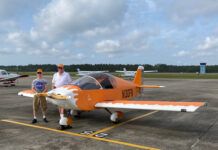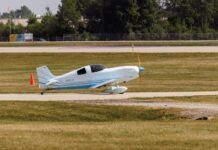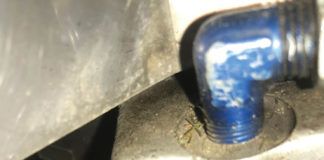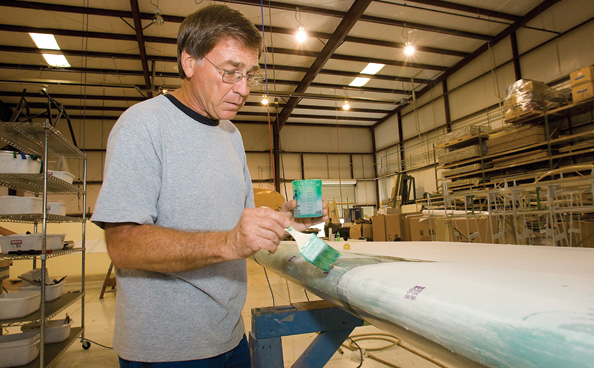
From the viewpoint of a work stool, cup of hot coffee in hand, you survey the landscape. Dusty wings hang from the ceiling of your shop, and the fuselage before you, an aluminum canoe, shows great progress compared to how it arrived on the 18-wheeler, but you have been seeing it the same way for months. In the corner of the garage, the lawnmower beckons; your spouse, for the umpteenth time, has reminded you of rain gutters that need cleaning or peeling paint on the southern exposure.
You have made a big investment, worked long hours to convince your family that constructing an airplane from pieces delivered by UPS is better than writing one really big check and having a flying machine from the start. You are far enough along that you now appreciate how much work—how many miscues to fix, mysteries to unravel—lie in your path. The coffee tastes good, and the grass really needs mowing…
We’ve All Been There
If this scenario seems too familiar, and the retelling of it encourages a rifle through Trade-A-Plane to see what other partially complete kits sell for, relax. You are not alone. Every builder has crossed this hurdle—every single one. It doesn’t matter if it’s a 300-hour lightweight or a 5000-hour plansbuilt project we’re talking about. There comes a time in a complicated, long-term, emotionally challenging procedure like building an airplane when doubts surface and progress feels snail’s pace—if not retrograde.
All can be overcome. Take some advice from those who have completed pro-jects, or who have at least surmounted obstacles during their own builds. We’re all in this together.
Shop Stats
A common theme when seeking advice from fellow builders is that you should make your workshop a destination not a dungeon. This means clearing dedicated space for your project, and making the surrounding workspace clean, comfortable and efficient.
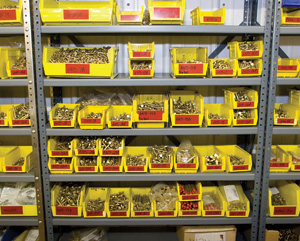
Organization will speed you toward the goal of having a flying airplane.
GlaStar builder Dan Dudley of Wisconsin suggests that your workspace does not have to be a million-dollar shop. “I built my GlaStar in half of a two-car garage,” he said. “That’s 22 by 26 feet—leaving the other half for the wife to park in. Also insulate and heat it. If that is not an option, dress warm and always stand on an insulated piece of carpet or a piece of Styrofoam, which really helps up here in the cold country.” Another builder carries on that theme: “One thing that is holding me up right now is that it is [expletive] cold outside, and my shop is not insulated. I did finally get a heating system installed a few months ago, but it is not really adequate to heat the shop without insulation. It is extremely hard to get motivated when it is below freezing outside and it takes an hour or more to get the shop to any reasonable temperature. So my advice is to create a comfortable working area, including whatever heating or cooling you need to work comfortably.”
For most of us, building is a part-time, when-I-have-the-time endeavor, so it’s critical that the workshop is ready when you are. A small investment in a heater or air conditioner will pay you back many times over in increased productivity.
Let’s take that a bit further. Organization and lighting come up often in discussions of shop design. You almost can’t have too much light. Your overhead lighting must be strong and bright, and be watchful for places where it can be improved. It’s common to place a workbench along a wall and install handy shelves or cabinets above it. But if the main light is behind you, the cabinets will shadow part of the bench. Go to your local hardware store and invest in under-shelf lights. A few extra lumens here and there will make you more comfortable and improve the accuracy of your work.
It’s critical that you keep your tools clean and organized, and be sure to create an inventory system for the kit components. First-time builders can regale you with tales of looking for that one part for an hour, only to discover it had fallen out of the paper bag it came in, rolled to the floor and remained hidden behind the workbench. It’s tempting to dig into the project as soon as the first big parts arrive, but take the time to put the pieces in order and double-check that the parts—hardware, particularly—are all accounted for. And then periodically check the inventory to be sure nothing has grown legs. A few AN3 bolts here and there won’t seem like a big expense, but waiting for UPS to deliver a replacement item can kill your momentum.
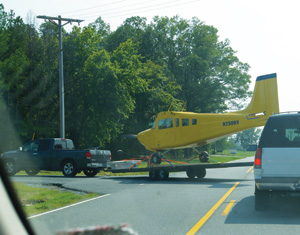
The fateful trip to the airport. Don’t do it too soon, and absolutely not more than once.
Home or Airport?
Another builder suggests that you “build as much as you possibly can at home. You will get more done than at some remote location.” Says another, “Having the project at home is a huge benefit. You can easily slip in a half hour or more, and when you get stumped, you can do things around the house and be with family until it ‘hits you’ what you should do. If you get in the habit of doing one thing every day, you will be shocked at how a huge project can take care of itself.”
Proximity is everything here, as long as you have managed to make the workspace compatible with other uses. Kicking the family cars out of the garage isn’t always advised, though many builders with room on the property have made peace with temporary buildings or shelters so that the displaced vehicles aren’t ravaged by the elements (or their drivers terribly inconvenienced).
The total amount of room you have and its configuration may dictate when you move the project to the airport, but almost unanimously the builders we talked to advocated keeping the project at home as long as possible. Some ways to lengthen the stay include finding secure storage elsewhere for the large, completed pieces—get them out from underfoot and make room for the other elements that inevitably get larger the further along in the program. Here’s where those friendships you made at the local EAA chapter may well pay off; you might finagle some low-cost storage space at a local’s hangar or shop in return for a ride once the project is done. Builders are a giving bunch, and you don’t know until you ask.
Often the inclination is to move to the airport when a hangar comes available or as a means of motivation—”I have to make hangar rent, and that will motivate me to get out there and make the time count.” This is the wrong approach, however, according to many builders. Instead of pushing you along toward the finish line, the cost of the hangar and the trouble of moving the project there can actually be impediments, and may chip away at what can be an incredibly fragile psyche. Keep it close, keep it simple, keep at it.
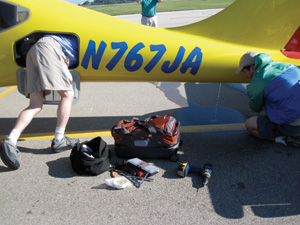
Building with friends is almost as good as flying with friends—just remember that even in a mature airplane, there’s always something. Being part of a type club can bring like-minded pilots and builders together. (Jon Apfelbaum’s GlaStar is relieving itself of trapped rainwater with the help of John Lake.)
Make a Plan
It’s true that most good kitbuilt designs have a logical set of manuals and, as much as is possible, step-by-step instructions. That’s fine, and you should always follow them when they’re available, but also consider these tips from a Chapter Tech Counselor for sheet metal and composites. “When I visit with builders, I always try to convey that it really doesn’t matter how much time they spend in the shop. What really matters is how much quality time they spend in the shop. Never walk into the shop not knowing what you want to work on. Always have a plan. If there are many things to do, make a list. Then work the list. If you find something else that needs to be done while you are working, add it to the list, but try to finish what you were doing. A list is especially helpful as you near completion. As things start getting done, and it starts to look more and more like an airplane, motivation will come easily. I fully believe that the real 51% of building an airplane is the builder’s attitude toward the work.”
Let’s circle back to one important point, an idea that’s critical to maintaining your momentum. If you stick to your plan, those items you discover need tending, or that great concept for improving your airplane won’t become dangerous, time-chewing distractions. Add them to the list, sure, but don’t stop work to act on them. The benefit of perspective is so great that it almost cannot be measured.
(There is, of course, a discussion all by itself about deviating from the plans—each modification you make, thinking you are smarter than the people who designed and built your kit, will inevitably set you back. It’s been proven time and again that the most efficient and painless way to build an airplane is to strictly follow the manufacturer’s guidance.)
“The worst times for me were the times I got stumped on a certain section and wasn’t sure which direction to go in. After I figured I had wasted enough time being unsure, I just went ahead and did it the way I thought would work. I figured at least I was doing something. That was certainly better than doing nothing, and most of the time it worked out just fine. A couple times I had to order some small replacement parts. That system worked for me,” says an experienced builder.
Another builder suggests that you “break every section of the build into small tasks that have to be completed. Try to complete one task before moving on to the next. If you need parts or have to order tools, move on to a different area, but always try to complete what you are working on before you move on. If you keep looking at all of your parts, or think about the plane as a huge project, or spend too much time reading ahead in the manuals, it will become overwhelming. Most important is to try to do something every day or at least every week.”
Man’s Best Friend
Don’t discount companionship during the build; it’s true that many builders choose the solitary life during construction, but there are downsides to that. Says frequent KITPLANES contributor Dave Prizio, “I found that having a friend (building buddy) who is really interested in the project and willing to work with me to be vital to making real progress. My building partner Ed Zaleski and I kept each other focused and motivated. Plus it was fun to work with a friend rather than to have building be something that took me away from interacting with friends. Another great thing is to have another builder nearby who can help you through some of the parts that are hard or confusing for you. We always try to lend support to other builders in that way whenever we can.”
But also learn to set limits. You probably have “friends” at the airport who will pop in to chat. Next thing you know, an hour has gone by and you’re no further along the task list. Here’s another advantage of working at home, unless your neighbors are just as curious.
Build a Budget, Too
Several builders recommended creating a rough-outline budget to be sure that you can actually afford the aircraft. Don’t sugar-coat it, and don’t make assumptions that favor the purchase. Be, in this aspect, pessimistic. But also remember that unless you’re building as part of an accelerated program, the rate at which you spend money is in your control. We have seen through this economic downturn that many builders, rather than abandon the project, have simply slowed progress or delayed purchasing the expensive items like engine, propeller and avionics. (In fact, you should leave your avionics choices until as late as possible because the technology changes rapidly.)
Remember, too, that you don’t have to fly the airplane in “final” form—you might have purchased a used engine with magnetos already in place. But you absolutely, positively want electronic ignition. Fine, make arrangements in the electrical system to support your choice, but consider leaving that expenditure until after first flight and commit to a retrofit. Properly planned, such an upgrade isn’t difficult.
Time Off/Big Picture
“Don’t let the building consume all of your time. Make sure you leave enough time to do other things. I’ve tended to get too focused on the building, then I get burned out and take a break, and it takes me awhile to get back into it. Build in moderation along with other things in your life, and maintain some kind of balance,” says one builder, sagely. Another suggests, “Don’t forget to make time for wife and family. If you lose their support, you will never finish.”
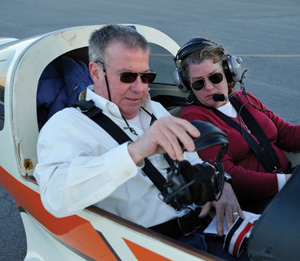
Spousal buy-in is critical to the success of any homebuilt project.
There is a distinction between enslaving your family members to help in the process and asking for their moral support and guidance. For example, bucking rivets quickly gets old for a teenager or a spouse who’s not really into the project. But asking for guidance and opinion on the paint scheme, interior design and other factors is a step in the right direction—don’t forget to ask members of your family for their preferences on things like inflight entertainment and other comfort factors. Toward that goal, be sure to attend air shows or other regional events so your spouse can see, touch and experience a completed example of your airplane. There is no better post-prandial conversation than, “Honey, I’ll do the dishes. Why don’t you get an hour in on our airplane?”
What applies to spending time with your family is also relevant to flying. One builder said that you should not “forget to go flying every once in a while to help with motivation. Go up with friends, or rent, or something, just get in the air at least every couple of months. If you can afford it, buy a relatively inexpensive Cessna 150 or Grumman Yankee, or something better if you can, so you have something to fly to maintain your flying skills. All work and no play makes Jack a dull boy.” Other builders dispute the idea of buying another airplane to fly while you build the project of your dreams, and it’s true that it can be another distraction. Better, perhaps, is to work out a sharing arrangement with another owner or find a clean rental airplane (good luck!) to help with your currency. Try to find another airplane in the general weight and speed range of the one you’re building for maximum currency transference.
And Remember…
“My five-year build started in March 1998,” says another GlaStar builder. “The wife and I were raising two boys, living on 20 acres and managing our own company. Other than that, not much going on. Everything went well until summer with the boys’ activities followed by fall soccer. Spring brought baseball. Most of the work on the plane got done in the dead of winter. In 2003, I sold the company, 2004 quit my job and 2005 sold the house. That meant the plane went into storage for two years. Now I’m building five days a week, 4 to 5 hours a day with weekends off so I don’t burn out. Remember, it’s supposed to be fun.”
In the end, the vast majority of builders are delighted with the fruits of their labor. Said one, “I’ve really enjoyed the build process. I love to tinker, but this has certainly slowed me down. Yet a major reason for building my own airplane was getting the satisfaction of making something with my own two hands that I’m going to actually fly one day. I’m certainly meeting that goal! What a hoot!”






